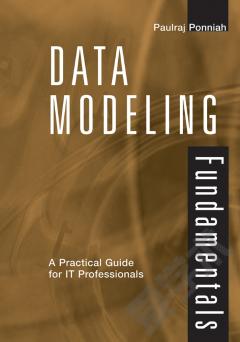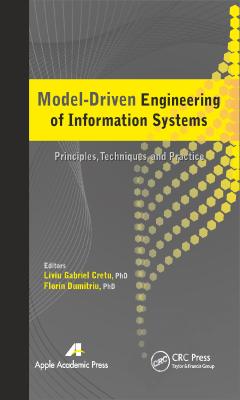Data Modeling Fundamentals —— A Practical Guide for IT Professionals
----- 数据模型化导论
Preface. Acknowledgments. PART I: INTRODUCTION TO DATA MODELING. 1. Data Modeling: An Overview. Chapter Objectives. Data Model Defined. What is a Data Model? Why Data Modeling? Who Performs Data Modeling? Information Levels. Classification of Information Levels. Data Models at Information Levels. Conceptual Data Modeling. Data Model Components. Data Modeling Steps. Data Model Quality. Significance of Data Model Quality. Data Model Characteristics. Ensuring Data Model Quality. Data System Development. Data System Development Life Cycle (DDLC). Roles and Responsibilities. Modeling the Information Requirements. Applying Agile Modeling Principles. Data Modeling Approaches and Trends. Data Modeling Approaches. Modeling for Data Warehouse. Other Modeling Trends. Chapter Summary. Review Questions. 2. Methods, Techniques, and Symbols. Chapter Objectives. Data Modeling Approaches. Semantic Modeling. Relational Modeling. Entity-Relationship Modeling. Binary Modeling. Methods and Techniques. Peter Chen (E-R) Modeling. Information Engineering. IDEF1X. Richard Barker's. ORM (Object Role Modeling). XML (eXtensible Markup Language). Summary and Comments. Unified Modeling Language (UML). Data Modeling Using UML. UML in the Development Process. Chapter Summary. Review Questions. PART II. DATA MODELING FUNDAMENTALS. 3. Anatomy of a Data Model. Chapter Objectives. Data Model Composition. Models at Different Levels. Conceptual Model: Review Procedure. Conceptual Model: Identifying Components. Case Study. Description. E-R Model. UML Model. Creation of Models. User Views. View Integration. Entity Types. Specialization/Generalization. Relationships. Attributes. Identifiers. Review of the Model Diagram. Logical Model: Overview. Model Components. Transformation Steps. Relational Model. Physical Model: Overview. Model Components. Transformation Steps. Chapter Summary. Review Questions. 4. Objects or Entities in Detail. Chapter Objectives. Entity Types or Object Sets. Comprehensive Definition. Identifying Entity Types. Homonyms and Synonyms. Category of Entity Types. Exploring Dependencies. Dependent or Weak Entity Types. Classifying Dependencies. Representation in the Model. Generalization and Specialization. Why Generalize or Specialize? Super-types and Sub-types. Generalization Hierarchy. Inheritance of Attributes. Inheritance of Relationships. Constraints. Rules Summarized. Special Cases and Exceptions. Recursive Structures. Conceptual and Physical. Assembly Structures. Entity Type Vs Attribute. Entity Type Vs Relationship. Modeling Time Dimension. Categorization. Entity Validation Checklist. Completeness. Correctness. Chapter Summary. Review Questions. 5. Attributes and Identifiers in Detail. Chapter Objectives. Attributes. Properties or Characteristics. Attributes as Data. Attribute Values. Names and Descriptions. Attribute Domains. Definition of a Domain. Domain Information. Attribute Values and Domains. Split Domains. Misrepresented Domains. Resolution of Mixed Domains. Constraints for Attributes. Value Set. Range. Type. Null Values. Types of Attributes. Single-Valued and Multi-Valued Attributes. Simple and Composite Attributes. Attributes with Stored and Derived Values . Optional Attributes. Identifiers or Keys. Need for Identifiers. Definitions of Keys. Guidelines for Identifiers. Key in Generalization Hierarchy. Attribute Validation Checklist. Completeness. Correctness. Chapter Summary. Review Questions. 6. Relationships in Detail. Chapter Objectives. Relationships. Associations. Relationship?Two-sided. Relationship Sets. Double Relationships. Relationship Attributes. Degree of Relationships. Unary Relationship. Binary Relationship. Ternary Relationship. Quaternary Relationship. Structural Constraints. Cardinality Constraint. Participation Constraint. Dependencies. Entity Existence. Relationship Types. Identifying Relationship . Non-identifying Relationship. Maximum and Minimum Cardinalities. Mandatory Conditions - Both Ends. Optional Condition - One End. Optional Condition - Other End. Optional Conditions - Both Ends. Special Cases. Gerund. Aggregation. Access Pathways. Design Issues. Relationship Or Entity Type? Ternary Relationship Or Aggregation? Binary Or N-ary Relationship? One-to-One Relationships. One-to-Many Relationships. Circular Structures. Redundant Relationships. Multiple Relationships. Relationship Validation Checklist. Completeness. Correctness. Chapter Summary. Review Questions. PART III. DATA MODEL IMPLEMENTATION. 7. Data Modeling to Database Design. Chapter Objectives. Relational Model: Fundamentals. Basic Concepts. Structure and Components. Data Integrity Constraints. Transition to Database Design. Design Approaches. Conceptual to Relational Model. Traditional Method. Evaluation of Design Methods. Model Transformation Method. The Approach. Mapping of Components. Entity Types to Relations. Attributes to Columns. Identifiers to Keys. Transformation of Relationships. Transformation Summary . Chapter Summary. Review Questions. 8. Data Normalization. Chapter Objectives. Informal Design. Forming Relations from Requirements. Potential Problems. Update Anomaly. Deletion Anomaly. Addition Anomaly. Normalization Methodology. Strengths of the Method. Application of the Method. Normalization Steps. Fundamental Normal Forms. First Normal Form. Second Normal Form. Third Normal Form. Boyce-Codd Normal Form. Higher Normal Forms. Fourth Normal Form. Fifth Normal Form. Domain-Key Normal Form. Normalization Summary. Review of the Steps. Normalization as Verification. Chapter Summary. Review Questions. 9. Modeling for Decision-Support Systems. Chapter Objectives. Decision-Support Systems. Need for Strategic Information. History of Decision-Support Systems. Operational Vs Informational Systems. System Types and Modeling Methods. Data Warehouse. Data Warehouse Defined. Major Components. Data Warehousing Applications. Modeling: Special Requirements. Dimensional Modeling. Dimensional Modeling Basics. STAR Schema. Snowflake Schema. Families of STARS. Transition to Logical Model. OLAP Systems. Features and Functions of OLAP. Dimensional Analysis. Hypercubes. OLAP Implementation Approaches. Data Modeling for OLAP. Data Mining Systems. Basic Concepts. Data Mining Techniques. Data Preparation and Modeling. Data Preprocessing. Data Modeling. Chapter Summary. Review Questions. PART IV. PRACTICAL APPROACH TO DATA MODELING. 10. Ensuring Quality in the Data Model. Chapter Objectives. Significant of Quality. Why Emphasize Quality? Good and Bad Models. Approach to Good Modeling. Quality of Definitions. Importance of Definitions. Aspects of Quality Definitions. Correctness. Completeness. Clearness. Format. Checklists. High-Quality Data Model. Meaning of Data Model Quality. Quality Dimensions. What is a High-Quality Model? Benefits of High-Quality Models. Quality Assurance Process. Aspects of Quality Assurance. Stages of Quality Assurance Process. Data Model Review. Data Model Assessment. Chapter Summary. Review Questions. 11. Agile Data Modeling in Practice. Chapter Objectives. The Agile Movement. How It Got Started. Principles of Agile Development. Philosophies. Generalizing Specialists. Agile Modeling. What is Agile Modeling? Basic Principles. Auxiliary Principles. Practicing Agile Modeling. Primary Practices. Additional Practices. Role of Agile DBA. Agile Documentation. Recognizing an Agile Model. Feasibility. Evolutionary Data Modeling. Traditional Approach. Need for Flexibility. Nature of Evolutionary Modeling. Benefits. Chapter Summary. Review Questions. 12. Data Modeling: Practical Tips. Chapter Objectives. Tips and Suggestions. Nature of Tips. How Specified. How to Use Them. Requirements Definition. Interviews. Group Sesssions. Geographically Dispersed Groups. Documentation. Change Management. Notes for Modeling. Stakeholder Participation. Organizing Participation. User Liaison. Continuous Interaction. Multiple Sites. Iterative Modeling. Establishing Cycles. Determining Increments. Requirements--Model Interface. Integration of Partial Models. Special Cases. Legal Entities. Locations and Places. Time Periods. Persons. Bill-of-Materials. Conceptual Model Layout. Readability and Usability. Component Arrangement. Adding Texts. Visual Highlights. Logical Data Model. Enhancement Motivation. Easier DB Implementation. Performance Improvement. Storage Management. Enhanced Representation. Chapter Summary. Review Questions. References. Glossary. Index.
{{comment.content}}








 京公网安备 11010802027623号
京公网安备 11010802027623号